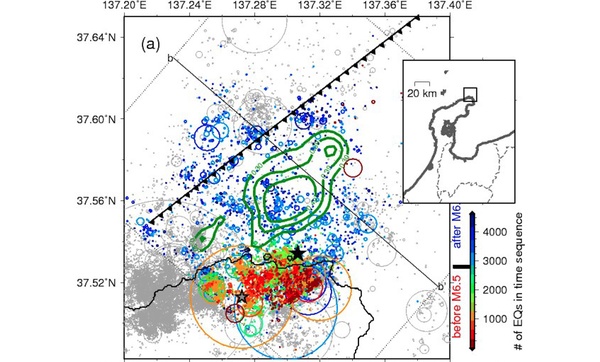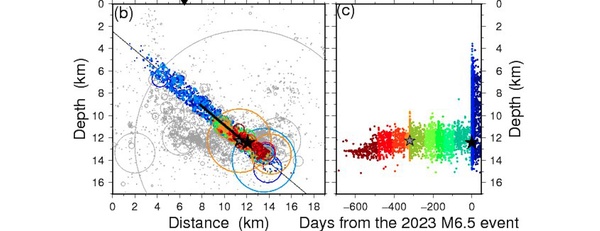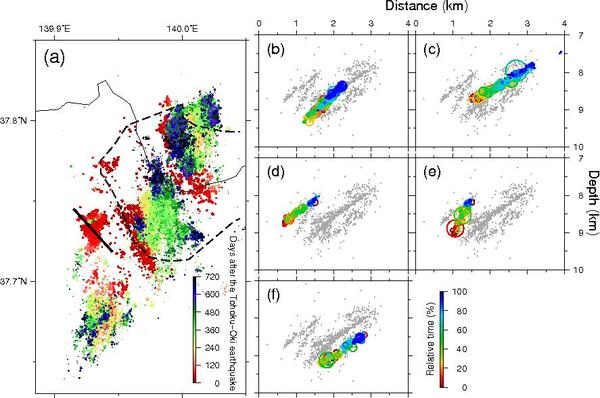Topics 2023.11.27
Upward earthquake swarm migration in the northeastern Noto Peninsula and the 2023 M6.5 earthquake
When fluids intrude into a fault, the fault strength decreases and earthquakes (fault slips) become more likely to occur. For this reason, it has long been recognized that fluid movement in the crust may influence the occurrence of earthquakes. Recent studies have revealed that fluid movement is involved in not a few earthquake sequences in the crust of Japan. Here, I introduce the recent earthquake swarm in the northeastern Noto Peninsula and the M6.5 event on May 5, 2023, as a prominent example.
Figure 1. Earthquake migration in the northeastern Noto Peninsula (Yoshida et al., 2023). Black and gray stars represent the 2023 M6.5 and June 2022 M5.4 events, respectively. The colors of the circles indicate the relative time of the earthquakes in the fault zone (within 1 km of the black line in b. Events outside the fault zone are gray). (a) Plan view. Contour lines indicate the slip distribution of the M6.5 event (unit: m). The square in the inset map indicate the map area. (b) Cross section. The black line shows the main slip segment (≥0.12 m). (c) Relation between earthquake occurrence time and depth in the fault zone.
In the northeastern tip of Noto Peninsula, Ishikawa Prefecture, the seismicity rate has increased since the end of 2020, with widespread surface displacements in the surrounding area. Precise determination of the earthquake hypocenters has revealed that during this swarm activity, the microearthquakes slowly moved from the deep to the shallow level through multiple planar structures (Figure 1). The geophysical imaging studies have shown that, beneath this swarm region, a deep seismic reflection region and a deeper seismic low-velocity and low-resistivity region exist, which may represent a fluid concentration region.
During this swarm activity, an M6.5 event occurred on May 5, 2023. The rupture started at the northernmost of the swarm area, near the top of the fault where the M5.4 event occurred in June 2022, and propagated farther updip (to the north), causing a large slip. The aftershocks intensely occurred on this southeast-dipping fault, surrounding the large slip area of the mainshock, mainly on the shallow side. The earthquake swarm, which started around the end of 2020 at a depth of 18 km, eventually reached a depth of 5 km during this sequence. This earthquake sequence and crustal deformation were most likely caused by the upward migration of crustal fluids stored deep in the crust through the complex network of faults.
An active fault called the Suzu-Oki segment exists near the M6.5 source fault. Still, the aftershock distribution indicates that the M6.5 event occurred on a different fault located deeper than the Suzu-Oki segment. The Suzu-Oki segment may still be under high strain.
Actually, such upward earthquake swarm migrations have been reported in different regions of Japan in recent years. For example, the characteristics of the Noto swarm are very similar to those of the swarm that started seven days after the 2011 M9 Tohoku earthquake near the Yamagata-Fukushima Prefecture border (Figure 2). Similar phenomena were also reported for the swarm activities at Sendai in Miyagi Prefecture, and at Mt. Gassan in Yamagata Prefecture, following the M9 Tohoku earthquake and that before the M5.3 earthquake in Kagoshima Bay in 2017. These observations suggest that fluid movement from deep to shallow crust affects the occurrence of not a few earthquake sequences in Japan. Among them, the case in the northeastern Noto Peninsula is significant as it indicates that an earthquake as large as M6.5 may occur during an fluid-induced earthquake swarm.
(By Keisuke Yoshida, Subduction Zone Science Laboratory)
Figure 2. An example of upward earthquake migrations around the Yamagata-Fukushima border (Yoshida & Hasegawa, 2018). (a): plan view. Colors indicate the time elapsed since the Tohoku earthquake. Black lines indicate locations of (b)-(f) cross sections. The dashed line represents the rim of the Ohtoge Caldera. (b)-(f): Vertical cross sections, shown for each fault. Colors indicate the relative occurrence time.
References
Yoshida, K., & Hasegawa, A. (2018). Hypocenter Migration and Seismicity Pattern Change in the Yamagata-Fukushima Border, NE Japan, Caused by Fluid Movement and Pore Pressure Variation. Journal of Geophysical Research: Solid Earth, 123(6), 5000-5017. https://doi.org/10.1029/2018JB015468
Yoshida, K., Uchida, N., Matsumoto, Y., Orimo, M., Okada, T., Hirahara, S., et al. (2023). Updip Fluid Flow in the Crust of the Northeastern Noto Peninsula, Japan, Triggered the 2023 Mw 6.2 Suzu Earthquake During Swarm Activity. Research Letters, 50(21). https://doi.org/10.1029/2023gl106023



